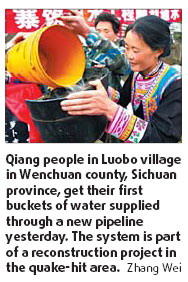Glad to know they are rebuilding their lives well!
 WENCHUAN, Sichuan: For thousands of years, the Qiang people in Luobo village more than 2,000 m above the sea level have had to collect or haul water for daily use.
WENCHUAN, Sichuan: For thousands of years, the Qiang people in Luobo village more than 2,000 m above the sea level have had to collect or haul water for daily use. "Getting enough water for drinking and other basic needs was always a top concern for us," Ma Luquan, 56, a farmer who grows corn in northern Wenchuan county, said yesterday.
Last year, Ma and about 1,000 of his fellow villagers from the Qiang minority ethnic group had to leave the area after the deadly earthquake struck Sichuan province on May 12 and devastated Luobo.
But when the Qiangs moved into their newly built homes in an area adjacent to their former village, they had a pleasant surprise waiting for them: a network of pipes carrying water from mountain streams.
"It's great the water pours into wells in our village and we don't have to walk very far now. It's such a simple thing and yet so important," Ma said.
The Qiangs are one of the 56 ethnic groups of the country, and have a population of more than 300,000. Most of them live in northwestern Sichuan.
Forty-four Qiang villagers died in Luobo, while almost all of the 200-odd buildings in their village were destroyed, village head Ma Qianguo said.
Luobo is one of the oldest Qiang settlements and used to be famous for its architecture and culture. The red radish - after which the village is named - grown there was famous for its taste and freshness.
But when the Qiangs moved into their newly built homes in an area adjacent to their former village, they had a pleasant surprise waiting for them: a network of pipes carrying water from mountain streams.
"It's great the water pours into wells in our village and we don't have to walk very far now. It's such a simple thing and yet so important," Ma said.
The Qiangs are one of the 56 ethnic groups of the country, and have a population of more than 300,000. Most of them live in northwestern Sichuan.
Forty-four Qiang villagers died in Luobo, while almost all of the 200-odd buildings in their village were destroyed, village head Ma Qianguo said.
Luobo is one of the oldest Qiang settlements and used to be famous for its architecture and culture. The red radish - after which the village is named - grown there was famous for its taste and freshness.


